|
1.
CENTRAL/ WEST AFRICA
West Africa trade not likely to pick up in third quarter
West African markets remained subdued over the month
of August and little change was expected through the rest
of the third quarter. The trading pattern established over
most of 2009 continued, with an emphasis on logs to Far
East destinations, very depressed business into Europe and
no signs of recovery in the global markets for sawn
lumber. West African producers and log exporters report
good business for a limited range of log species and prices.
Where prices have hardened in recent months, these have
now firmed again with further price increases for the more
popular logs. While trade has not been brisk over the past
months, regular log shipments for China, India and
Vietnam have kept prices very steady and recent modest
gains for the most favored species have been maintained.
Some exporters report possible further small increases
because of low supply.
In Gabon, there were rumors of operators already either
running short of their log export quota allowance or even
on the brink of running out of quota altogether during
August. By mid-September, some producers in Gabon did
exhaust their allowable log export quota. As previously
mentioned, there had been protracted negotiation with the
government to increase the quotas and reports are that
several producers have now received further allocations.
At the current demand levels for export volumes it may be
likely that even these may not be sufficient to carry
through to the end of the year. Congo Brazzaville seems
also to have postponed limitations on log exports and there
is no doubt governments have relaxed intended constraints
in order to keep the timber industry solvent and maintain
employment through the difficult trading conditions.
Although most sawn lumber prices have also remained
steady overall, with very few falls in the past three
months, it is unlikely that exporters would restart sawmills
and other processing facilities or even increase production
on those still running unless and until there is a surge in
buying for Europe. Up to present there are no signs that
European business will revive even though the Continental
vacation period is now ended and importers are reviewing
trade prospects for the autumn and winter. Building and
construction activity have not improved, the downturn has
been fairly evenly spread across Europe, Spain and UK
possibly the worst hit.
Sawn lumber is in the doldrums and business with Europe
has been very dull as the usual autumn surge in purchases
by UK and Continental European buyers has not occurred
this year. Although the UK construction industry is said to
be more active, this has not so far translated into new
timber imports and at this time the only reasonably bright
spot is Italy where there has been over the past months,
and is, a steady level of imports of favorite species in logs
and lumber. Sawn lumber prices have changed a little for
the very few species that are being actively traded, while
the majority have kept steady over several months through
the absence of demand or extremely low offtake matching
the very low level of production and low stocks at
producer mills.
Cameroon reports heavy rains hampering production and
Gabon producers are expecting early onset of the rainy
season.
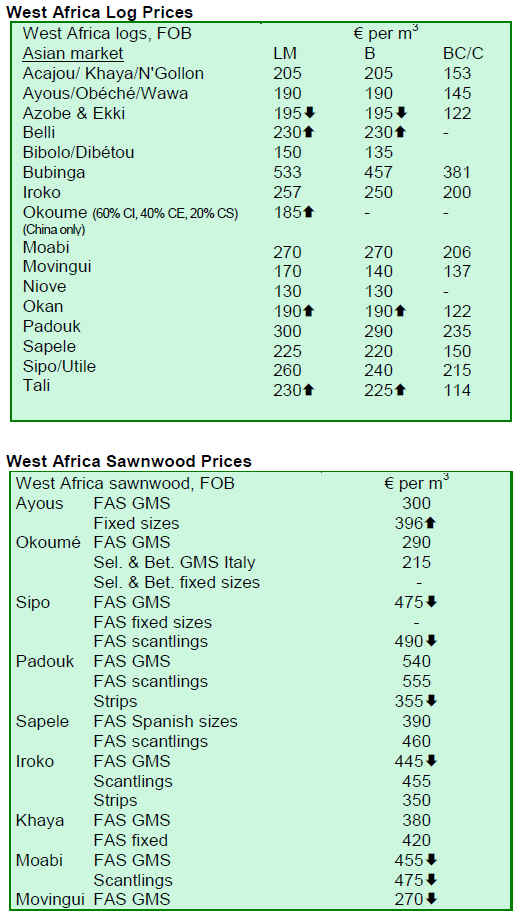
2. GHANA
TIDD contact volume jumps nearly 21%
According to the Timber Industry Development (TIDD)
Division of the Forestry Commission (FC), a total contract
volume of 129,580 m³ of wood products and 5,388 pieces
of furniture were processed and approved during the
second quarter of the 2009. These compared to the first
quarter of the same year show increases of 20.9% in the
total contract volume for wood products. The timber trade,
which was severely hit by the global economic slowdown
during late 2008, has shown signs of recovery from the
crises as shown in figures since October 2008.
All the major products experienced significant increases in
volume. Teak poles/billets/logs/lumber, plywood, sliced
veneer, and mouldings/processed lumber increased by
44%, 56.5%, 31.3%, and 124.5% respectively as compared
to the previous quarter figures to reflect volumes of 52,377
m³, 41,216 m³, 8,371 m³, and 4,163 m³. There was a
marginal increase of 2.1% for rotary veneer by volume
(3,795 m³) when compared to figures for the previous
quarter, although the market was generally down.
Price levels improve during second quarter
During the quarter under review, timber and wood product
exporters found it difficult to achieve the Guiding Selling
Prices (GSP) of the TIDD. However, the general price
levels achieved were much better when compared to those
achieved during the first quarter.
Prices of mahogany (Khaya Ivorensis) sawnwood
improved significantly during the quarter under review.
There were improvements of between USD60 and
USD80/m³ from the previous quarter. Prices reached
USD700/m³ and USD720/m³ for 25mm thickness, though
still falling below the GSP of USD788/m³. Wawa also
improved during the quarter under review although the
improvement was dependent on the exporter and the
volume involved. Many of the large scale and wellestablished
companies such as Logs and Lumber Ltd., the
Naja David Group of Companies, John Bitar Company
Limited and other medium scale companies were able to
achieve the GSP, and even above in most cases, small
scale companies found it difficult to achieve the GSP.
While the former were achieving between EUR5 and
EUR15 more on the GSP of EUR282/m³ for 25mm
thickness, the latter were achieving between EUR5 and
EUR18 below the GSP.
For the main species to the Middle East market, only the
dahoma showed signs of improvement, while prices of
edinam, danta, candollei, and mahogany
(Anthotheca/Grandifolia) did not improve during the
quarter under review. Prices of dahoma were up by
between USD10 and USD20/m³ in most cases from the
previous quarter.
The market for odum which had been generally down
since the middle of 2008, showed signs of recovery. A
significant number of contracts were submitted during the
quarter under review though prices were still EUR20 and
EUR45 below the GSP of EUR665/m³ and EUR670/m³
for 25mm and 50mm respectively. The US markets saw
some improvement, with the main buyers (Baystates Inc.,
MBS Trading and Munro Brice) signing contracts with
encouraging prices during the quarter under review.
Second quarter exports slump
Ghana*s timber exports trade declined as exporters traded
in few volumes of timber and wood products. For the first
half of the year ended June 2009, the value of exports
slumped by 35% as the result of a 30% fall in the export
volume of timber and wood products, when compared to
the same period last year. Total value of timber exports for
the first half of June 2009 was EUR62.72 million as
compared to EUR96.50 million, as shown in the table
below:
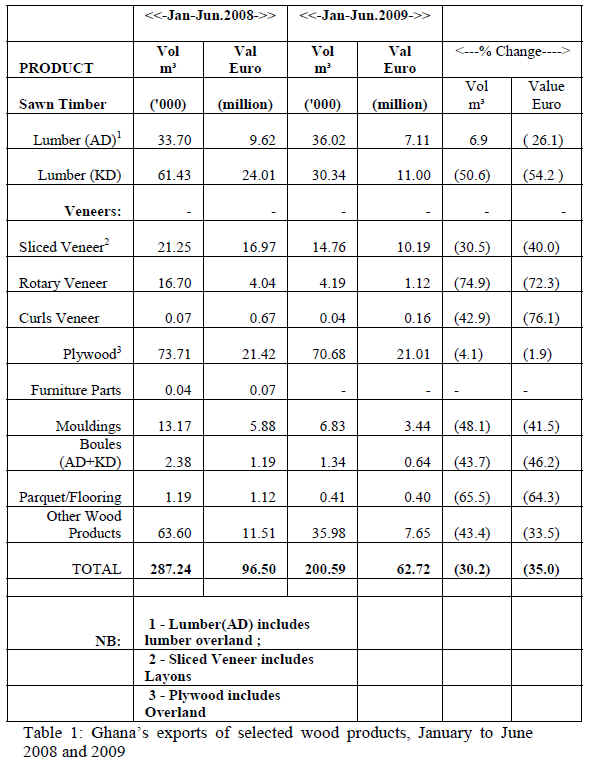
During the period under review, most products recorded
losses both in export volume and value. Ghana*s trade
with African markets for the period under consideration,
however, increased in both volume and value. Total
revenue increased to EUR27.49 million (43.8%) in 2009,
from EUR22.05million (22.8%) in 2008. Ghana*s trade
with major markets in America and Europe also declined
during the period, attributed largely to limited cash flow of
most buyers in these countries. Logging activities from the
forest was also difficult due to the rainy season.

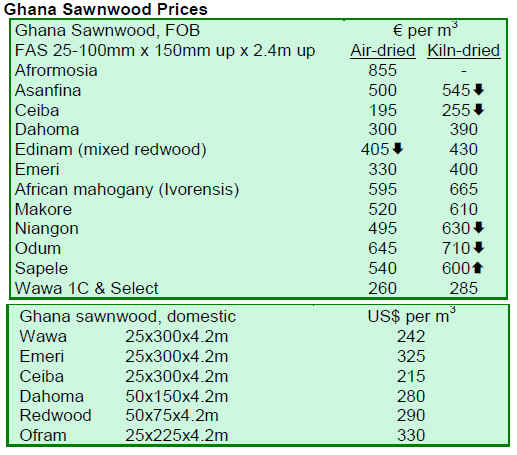
3.
MALAYSIA
Malaysia expects to reach furniture target
According to Bernama, the Malaysian government says it
is confident the country will be able to achieve a RM10
billion export target for its furniture exports by the end of
2009. The country has already registered RM3.57 billion
in furniture exports for the first half of 2009 compared to
RM4.11 for the same period last year.
To further promote its furniture products, Malaysian
traders will participate in the upcoming Malaysian
Furniture and Furnishings Fair. Its organizing chairman
Gan Tai Hwa expects total sales turnover is projected to
increase to RM50 million this year compared with RM40
million registered in last year*s fair.
Rubberwood gets a boost from latex demand
The continual usage of rubberwood as the main raw
material by the furniture industry has captured the
attention of investors, who are now interested in the
cultivation of rubber trees on a very large scale. One of the
latest joint ventures in the rubber plantation business by
the private sector involves Guangdong Guangken Rubber
Group, from China, and Bornion Timber Sdn Bhd, from
Malaysia, a 12,000 hectare rubber tree forest plantation
estate in Sabah with an initial investment of RM230
million.
Rubber experts claimed in The Star that those who have
invested in rubber tree plantations could expect an internal
rate of return (IRR) of up to 12.8% from rubberwood
alone. Over a 15-year period and with latex production
factored in, the IRR could reach up to 13.7% in
comparison with other plantation forest species, which
yield an IRR ranging from 5.1% to 15%. The IRR of
rubber tree plantations is comparable to the IRR of oil
palm plantations, which stands at 15.6%.
Companies undertaking new forest plantation projects in
Malaysia are provided a 10 year tax holiday beginning the
first year the company begins to make a profit. Those
involved in reinvestments will receive five years tax free
beginning the first year it makes a profit.
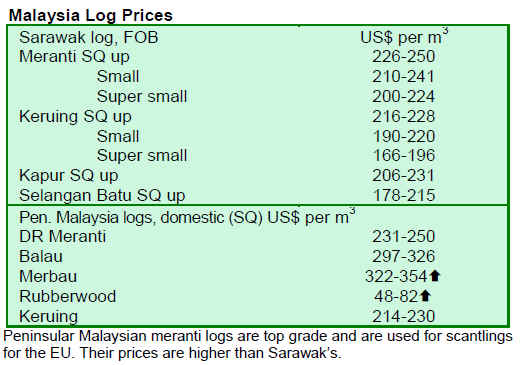
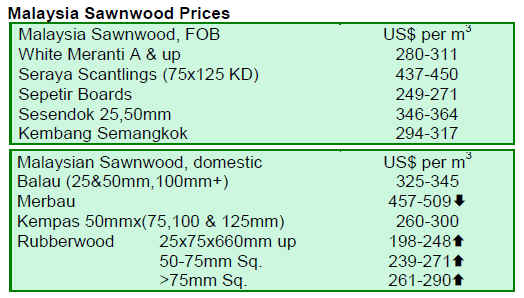
4.
INDONESIA
Indonesia works to approve S4S exports
The Indonesian government is working on a plan to
legalize the exportation of S4S (surface-machined to a
smooth finish on all four sides) categories of wood and
logs from natural forests, which are currently banned, in
an effort to boost revenue from the forest products
industry. Indonesian officials are of the opinion that
despite of the current global economic crisis, there is
demand for S4S and log products in particular markets,
especially in the Middle-East. Officials added that
countries like Malaysia and China had benefited from
Indonesia*s absence in the global market.
The Jakarta Post reports that the Ministry of Forestry has
set quotas allowing harvesting of up to 9 million m³ of
logs per year. However, official statistics state that only 3
million m³ of logs actually entered into production.
Officials are questioning whether the remaining 6 million
m³ was harvested and processed illegally, including to
process products into S4S. Conservationists and a number
of NGOs noted that the Indonesian government must
improve on a mechanism that allows for transparency and
good governance in forestry management before
embarking on a plan to legalize exportation of S4S.
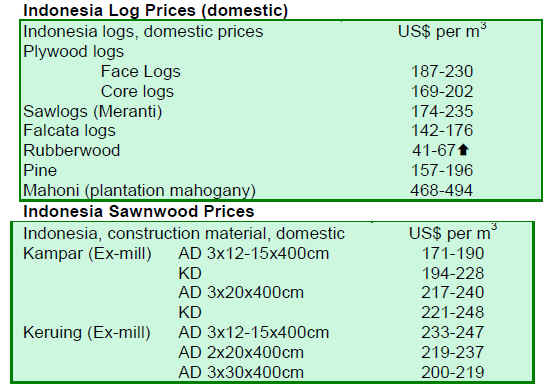
5.
MYANMAR
Community forestry plantation boosts agarwood
availability
A community forestry plantation situated about eight miles
from Myitkyina, Kachin State, in Northern Myanmar was
established under a directive from the Ministry of
Forestry*s aims to replenish agarwood (Aquilaria
agallocha- Thymelaeaceae family) saplings. As reported in
The New Light of Myanmar, agarwood is considered to be
on the verge of extinction. The community forestry
plantation had started sowing agarwood seeds in April
2008 and by June 2009 planted 12 acres. About 500 acres
are expected to be planted under the initiative.
The seeds for the plantation were initially collected from
trees in the nearby villages. About 100,000 seedlings were
planted last year and sold to those interested in
establishing plantations at the rate of Kyats 500 (about 50
US cents) per sapling. The Ngwe Pyaw Agarwood
Plantation expects to plant another 100,000 seedlings this
year. About 500 trees with a spacing of 10 feet by 10 feet
can be planted per acre.
Agarwood trees are injected with microbes at three years,
and can be utilized at five years. Old agarwood trees in
nearby villages have straight boles and can grow up to
about fifty feet in height. Agarwood is known to have
medicinal properties and is highly popular in the Middle
East. Prices are reported to vary up to USD20,000 per
kilogram.
Plans designed to restore tidal forests
According to the Flowers News Journal, plans are being
drawn up to rehabilitate tidal forests in the Tanintharyi
Division. Records show that in 1980 the tidal forests
extended to 647,571 acres. However, the area only
spanned 587,776 acres in the year 2000 and 489,025 acres
in 2008. Deforestation levels between 1980 and 2008 are
attributed to human intervention such as the establishment
of embankments and subsistence farming in the lowlands;
expansion of fish farms; and fuel wood and charcoal
production. Plans are now underway to rehabilitate
mangroves that have been cut for various purposes and to
provide effective protection the remaining tidal forests,
thereby preserving the flora and marine life.
Tidal forests are to be found in Ayeyarwaddy, Yangon,
and Taninthatyi Divisions and in Rakhine and Mon States.
The largest areas of mangroves are to be found in the
Rakhine State, Ayeyarwaddy Division and the
Taninthatryi Division.
Market situation in Myanmar continues to be slow
The market situation remains as it was in July except some
buyers reported a glut of pyinkado logs in Vietnam.
Shipments to Vietnam are weakening. Teak was being
shipped to India and the Indian teak market was reported
to be quite firm.
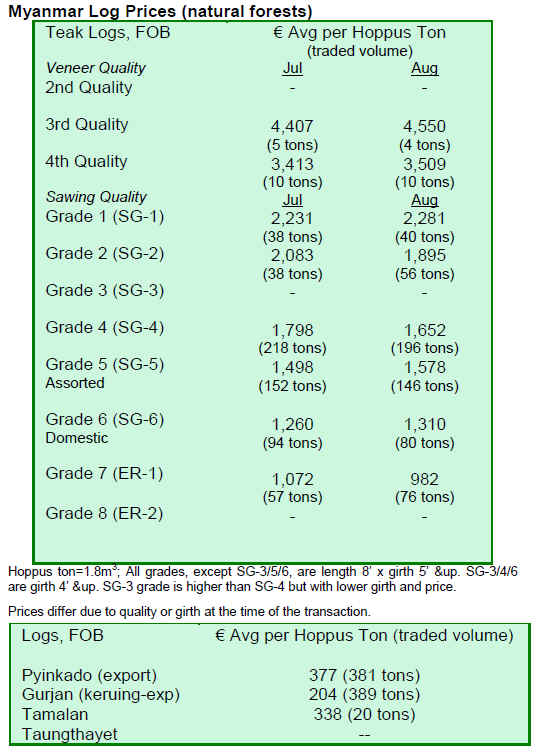
6. INDIA
Expansion of Special Economic Zones to increase wood exports
Annual tree planting programmes have been quite active
in many Indian states during 2009. Forest departments of
all states, non-government organizations (NGOs) and
members of the public have planted a large number of
saplings of teak, eucalyptus, casuarinas, poplar, leucanea
leucocephala, Dalbergia sissoo Bamboo and other species
by local wood-based industries. In certain areas, emphasis
has been on planting fruit and shade giving trees.
Sandalwood is also an important but rare species. Recent
reports indicate that the number of sandalwood trees has
increased in the Marayur sandalwood division from
57,767 to 58,514. There has been sufficient regeneration
of this species in the wild and vigilance and protective
measures by local forest departments have shown to
reduce smuggling cases as well.
India*s Foreign Trade Policy for the period 2009-2014 has
been just announced. In the new policy, the government
looks forward to achieve an annual export growth of 15%
over 2010-2011 with a target of USD 200 billion by
March 2011.
Special Economic Zones are expected to produce goods
for export. The first wood-based products areas will be
established in the State of Gujarat close to two of west
coast ports Kandla and Mundra. Timber processing zone
with about 400 licensed saw mills and about 35 plywood
units exists in the same district, providing direct
employment to 40-50,000 people. The planned size of the
SEZ is 100 hectares and is expected to attract Rs.10 billion
in investment for wood-based industries.
Indian exporters and industry will benefit from the
recently signed Association of South East Asian Nations
(ASEAN) Free Trade Agreement as it will eliminate
import duties on over 4000 items in intra-regional trade in
ASEAN markets. The measures are expected to enlarge
volumes traded and boost economic return for all the
participants. Under the new Agreement, India can export
more units of plywood, MDF, particleboard, but is limited
by availability of raw material. This FTA has generated lot
of optimism and opportunities.
The global recession has affected India*s imports and
export levels. In fact imports have declined more than
exports so trade balances are being well managed. Exports
of wood products are performing better than the second
quarter of 2008. A comparison of figures is presented
below:
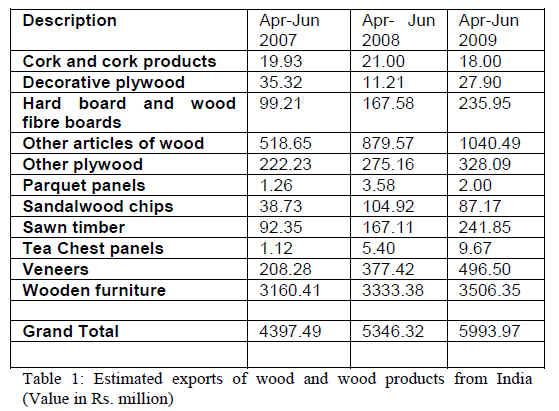
Teak prices show firm price trends
Teak prices have been strong over the last fortnight.
Below are countries which export teak to India (from
sources other than Myanmar) at current C&F prices for
Indian ports:
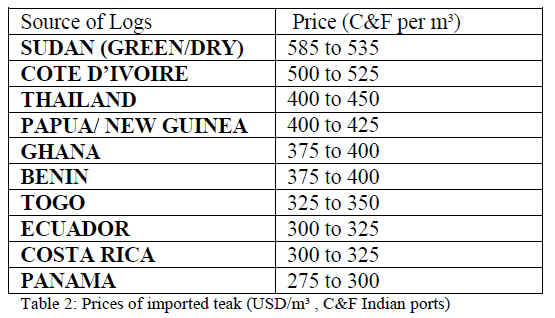
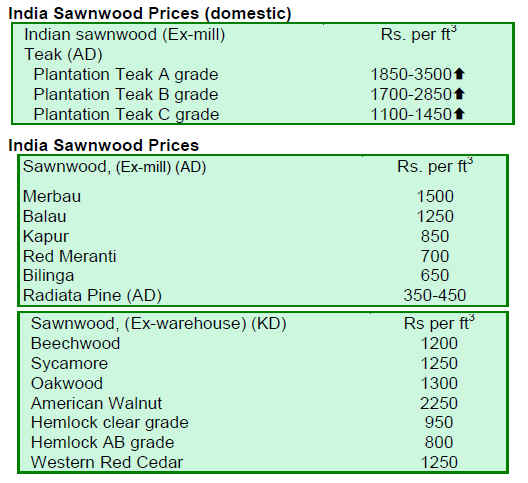
7. BRAZIL
Para authorities discuss alternatives for timber production
The government of state of Par芍 and forest sector
entrepreneurs have come up with alternatives for the
timber production chain. In August 2009, the State
Secretary of Development, Science and Technology
(SEDECT) discussed the main shortcomings of the sector.
Representatives indicated that the Forest Management
Support Program (PAMFLOR) could help promote forest
industry. According to Ag那ncia Par芍, the program aims to
improve sustainable forest management in Par芍 with more
transparency, stronger management, and greater
environmental control over forest resources. The
government, entrepreneurs and research institutes are
expected to be part of an independent and integrated
network system to increase the capability and swiftness of
the State Secretary of the Environment (SEMA) in the
process of analyzing and monitoring forest management
projects. PAMFLOR will provide a system of remote
monitoring and independent verification of forestry
practices in the field; technical assistance; capacity
building and training; technological improvements in
forest industry; and, production of studies that provide
strategic information on the forest sector.
New research aims to map wood production
A study carried out by the Economics Department of the
State University of Mato Grosso (UNEMAT) aims to map
the wood production processes in the Amazon region. The
purpose is to check the volume of wood residues produced
by the forest activities (furniture and timber industry) and
its potential as an alternative source of income. There are
many types of wood residues subject to utilization because
they may harm the environment and cause problems such
as forest fires. The alternative is to diversify the work and
income sustaining small companies and cooperatives.
The data collection for the completion of research is
expected to end by mid-July of 2010, reported S車 Not赤cias.
According to the proposal, the data collection will take
place in an area equivalent to 400 to 500 km². The Timber
Industry Association of Northern Mato Grosso
(Sindusmad), the Brazilian Support Service for Micro and
Small Enterprises (Sebrae) and Fapemat (funding agency)
are partners on this initiative. For the coordinators, the
Northern region has potential to transform wood residues
(sawdust, wood chip and others) into manufactured
products for commercialization.
The map being prepared in the region shows that only in
Santa Carmen (since the beginning of timber exploitation)
over 100,000 tons of wood waste has been produced. In
Marcelândia, such a figure tops 10 million tons.
Brazil*s exports show no sign of improvement
Brazil*s wood products exports for July 2009 (except pulp
and paper) plunged 41% by value, nearly the same amount
as in June 2009, compared to the same period in 2008. The
charts below show the volume and value of Brazil*s
exports for July 2009 compared to the same month a year
earlier:

Timber exports decrease in Roraima
Few timber companies in the Amazon meet the
environmental and labor law requirements of Brazil. In
Roraima, out of 54 timber companies, only one exports
certified wood mainly to the European market. The
business sector argues the global financial crisis is the
main factor that leads them to abandon plans for
certification, indicated Portal Amazônia.
To avoid uncontrolled deforestation, mainly in the
Amazon, some measures have been established to
stimulate investors* interest in self-sustaining actions.
Forest certification is one of them and serves as a passport
for companies that export processed timber.
Certification is a guarantee that timber companies comply
with forest management requirements. For instance, rare
or young trees are kept intact and are replanted every 25
years to allow forest regeneration. In the first half of 2008,
companies in the state of Roraima exported about USD
5,536 million. This year, in the same period, exports fell to
USD4,674 million. According to the Timber Industries
Union, this fall was due to the international financial
crisis.
Biom車vel seeks to boost Northern Santa Catarina*s competitiveness
According to Ag那ncia Sebrae de Not赤cias, most furniture
companies of the Northern Santa Catarina region used to
export 100% of its production from 2003 until 2008.
However, the global economic slowdown that began last
year reduced exports by 50%.
The region produces high quality furniture, made of solid
wood and following strict European quality standards, but
adverse exchange rates resulted in a loss of
competitiveness. One of the solutions to reverse this
situation was to shift production to the domestic market, a
measure promoted by the Local Productive Furniture
Arrangement (LPA) of the Northern Santa Catarina.
To further promote products from the region, 27
companies in the region created a label called &Biom車vel*,
launched in May 2009 to promote the concept of
sustainability in their products. To apply for the right to
use the label Biom車vel, a company must be a member of
the LPA Northern Santa Catarina and are subject to the
evaluation of a certification committee, the Conformity
Assessment Body.
The creation of this concept has come as a result of
extensive research on certification processes already used
by furniture manufacturers in other countries and by other
sectors. The strategy of Biom車vel integrates all levels of
product development, by linking competitive advantages
such as utilizing materials from planted forests and
reducing waste and producing environmentally friendly
products.
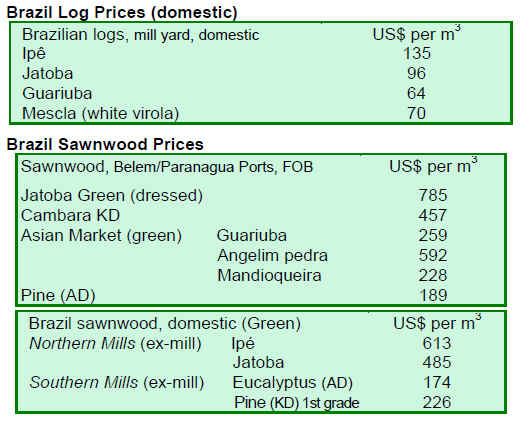
8.
PERU
Peru*s wood exports plummet 45%
According to the Export Association of Peru (ADEX),
wood exports from January to June 2009 were valued at
USD66.01 million while for the same period in 2008 were
USD119.76 million, a drop of 45%. The three main export
destination markets were China, Mexico and the US,
which together represented nearly 78% of wood sector
exports. The Bolivian market increased its imports and
New Zealand*s market continued to grow. On the other
hand, Mexico curtailed its imports by 71% following a
substantial reduction in imports of mouldings. China,
Mexico and the US all reduced their imports in the month
of June 2009 when compared to the same month of 2008.
In contrast, Venezuela increased its imports of 56% in the
month June 2009 compared with the same month 2008.
Semi-manufactured products during the period comprised
40.2% of wood exports worth USD26.54 million. The
main destination market for products from this sub-sector
was China. Hong Kong SAR also increased it imports of
semi-manufactured products by 80.7% in the same period.
Sawnwood amounted to 36% of wood exports in the
sector, although overall exports fell 58% by value from
2008 levels. Exports of veneer wood and plywood for the
January 每 June 2009 period were USD6.96 million, about
55% less than the same period in 2008.
Exports of furniture and parts also dropped to USD3.66
million by value in 2008. A large drop in demand from the
US contributed to the overall 47.7% decrease in wood
exports by value.
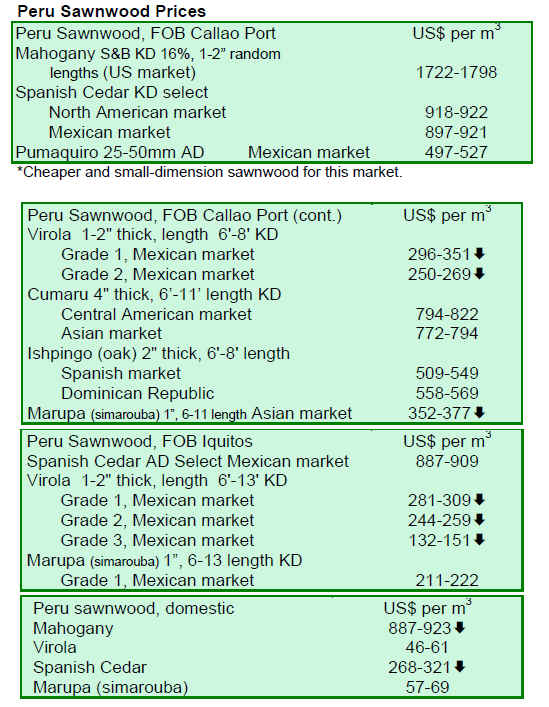
9. BOLIVIA
FSC covers over 2 million hectares of Bolivia*s forests
Bolivia is the world leader in voluntary forest certification
with more than 2 million hectares certified in tropical
forests. According to the FSC, Bolivia*s FSC certified
wood products exports are worth about USD16 million
annually, about 25% of total wood products. Only those
organizations or companies with chain of custody
certification can use FSC stamps in their products.
The FSC has an international office located in Bonn,
Germany, four regional offices (Europe, America, Africa
and Oceania - South East Asia) and a network of National
Initiatives. In Bolivia the FSC National Initiative is the
Bolivian Council for Voluntary forest certification - CFV.

10. MEXICO
National Forest Agency sees change of leadership
On 1 September 2009, Emilio Flores Dominguez was
appointed as the new Attached General Director of the
National Forest Agency (CONAFOR), replacing Carlos
Rodriguez Combelles, who is retiring from public service.
Flores was Federal Deputy in the National Action Party in
the LX Legislature, where he was part of the committees
of Environment and Natural Resources and Public
Finance. During his tenure as Federal Deputy, he
introduced various initiatives for the protection of wildlife,
aquifers and forests. He previously served as
commissioner of Banobras in the state of Chihuahua for
nearly four years. The National Forest Agency was created
as part of a decree that states gives the Attached General
Director clearance to conduct CONAFOR*s affairs in the
absence of the General Director.
Drought and arid conditions affect reforestation processes
The prolonged drought and lack of rainfall in large parts of
Mexico have affected the process of reforestation. Given
this situation, the CONAFOR has postponed the
establishment of nurseries where the drought continues.
As part of the ProTree program, about 25% of the
seedlings dedicated to reforestation in 2009. CONAFOR
expects that rainfall conditions be regularized in order to
meet the goals of reforestation programs at national and
state level. Otherwise, the plant would be sheltered in the
country*s forest nurseries.
Reforestation in the rural colony of Los Lirios, in the city
of Chihuahua, has been particularly high during the second
half of July this year. It was feared that a scenario of low
rainfall could present a similar drought occurred in the
summer of 1997 or 1982.
11.
Guyana
Greenheart continues positive gains
A comparison of the present period (16 每 31 August 2009)
and previous fortnight reveals a significant increase in the
prices for Greenheart logs. Greenheart small sawmill
quality and Purpleheart standard sawmill quality maintains
price stability. India was the main export destination
attracting logs. Both dressed and undressed sawnwood
prices have been very positive. Dressed greenheart has
shown a positive increase (1150/742 USD) for the period
16 每 31 August 2009 when compared to the previous
fortnight in August. However, dressed purpleheart remains
firm. Roundwood prices were favorable the second half of
August against the previous period. Splitwood prices
showed positive increases for the period 16 每 31 August
2009 when compared to the previous period (1st -15th
August 2009). Plywood prices for the BB/CC and utility
category have increased significantly for this period in
comparison to the first half of August.
Indoor and outdoor furniture and doors have revealed
higher prices for the second half of August while
mouldings, spindles, windows and wooden utensils and
ornaments also contributed to value-added products that
gained significant export value earnings for these
products.
FPDMC strengthens ties with forest industry
A recent consultation held between the Forest Producers
Association (FPA) and the FPDMC resulted in discussions
on areas relevant to Guyana*s forest industry.
Collaborative efforts are being made between the Guyana
Forestry Commission (GFC), the FPDMC and the FPA to
improve on export of wood and wood products in Guyana.
Eight Lesser Used Species (LUS) recently tested have
shown comparable properties with the more popular
species and have been accepted in accordance to ITTO
standards. Currently three of them are among the top ten
exports from Guyana to international markets. This has
resulted in part from a pro-active initiative undertaken by
the FPDMC to support the GFC in the initiative to
increase an awareness of the Lesser Used Species (LUS)
of accepted standards. Additional efforts by the FPDMC
are in progress in the areas of promotion and marketing of
LUS.
During the consultation it was noted the next phase in the
LUS promotion program would encourage local lumber
yards and traders to stack and sell LUS. It is anticipated
that eight additional LUS and their abundance will be
identified and quantified in the near future.
Another initiative that is supported by the FPDMC places
emphasis on industry efficiency and product development
within the sector. In order to achieve this, efforts to train
persons working in the sawmilling industry has
commenced and will be ongoing. In-house training will be
embarked upon in the near future in areas such as mill
design, saw doctoring and quality control.
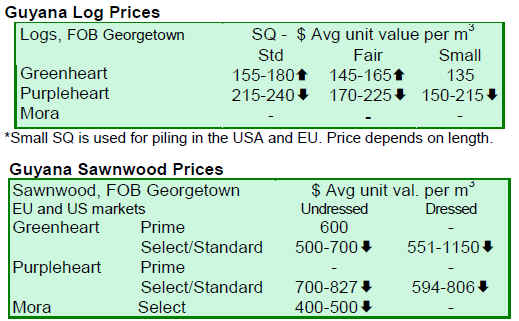
|